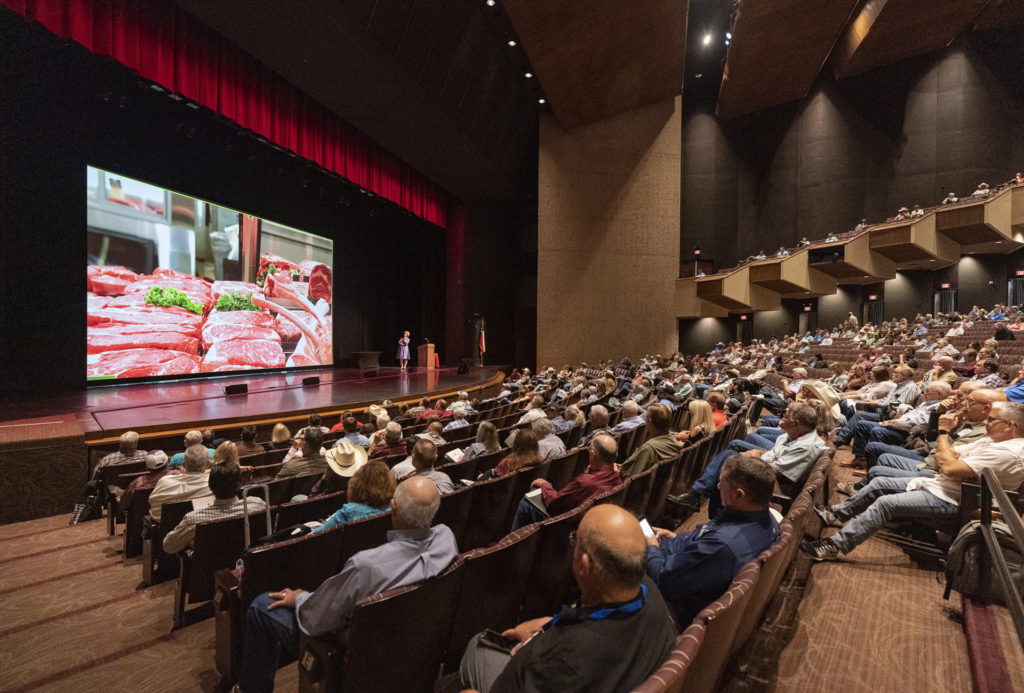Texas A&M Beef Cattle Short Course helps ranchers manage bottom line
Hybrid format reaches almost 1,900 across U.S., nine other countries
Equipping cattle producers with the knowledge and tools to improve their bottom line is the goal of the Texas A&M Beef Cattle Short Course, which is coordinated by Texas A&M AgriLife Extension Service and held on the Texas A&M University campus each August.

Join us for video and photo highlights of this event
The Texas A&M AgriLife event is a premiere example of the land-grant mission in action, bringing together experts, researchers and Extension specialists to provide producers, industry leaders and educators the most comprehensive look at the beef cattle industry.
“This program directly impacts producers and the beef cattle industry, equipping them with knowledge, tools and resources to improve, adapt and grow their operations to meet ever-changing industry/consumer needs,” said Jason Cleere, Ph.D., AgriLife Extension beef cattle specialist in the Texas A&M Department of Animal Science and conference coordinator.
This year’s event attracted 1,645 in-person participants and 253 virtual participants from 25 states and nine countries. The industry trade show had 128 exhibitors.
“Managing the bottom line and trying to add value to your cattle” was the general theme for the 26 different “Cattleman’s College” sessions and a general session held during the three-day event, Cleere said.
Managing the bottom line
In a message during the general session, Justin Benavidez, Ph.D., AgriLife Extension economist, Amarillo, provided producers with some good news on cattle prices but some caution about feed prices and the need to manage their risk.
“I expect calf prices and cull cow prices to be higher through the fall, and for them to remain high and rise for the next three to five years, based on the cattle cycle and widespread drought in the west,” Benavidez said.
He said the market has already seen 450-pound calf prices as high as $1.90 per pound, 750-pound calf prices as high as $1.60 per pound, and five-area slaughter prices as high as $1.27 per pound.
“But costs are also higher this year and will probably remain high for a while,” Benavidez warned. “The drought in the west eliminated a lot of hay acreage and is impacting some grain production as well. Additionally, reopening pressure and inflationary pressure has input prices higher than the previous year.”
Risk management tools can help mitigate some of the risks in the market, he said. The following programs could be considered:
– The Livestock Forage Program indemnifies producers for lost grazing due to drought.
– Livestock Risk Protection is a federally subsidized price insurance program that functions like an options contract, and prices can be locked in months ahead.
– The Pasture, Rangeland and Forage program is a rainfall insurance program that indemnifies producers if rainfall is less than expected.
“Risk management doesn’t mean that these programs will net a positive return every year, but, over time, these tools contribute to consistent, stable returns,” Benavidez said.
Risks, opportunities beyond the marketplace
Demographic changes and lack of general knowledge among consumers are resulting in a lack of understanding about how beef products are produced and marketed.
Very few people are involved in the day-to-day production ag workforce – 1.3% – so there is a definite lack of knowledge amongst the general public of what beef producers do or need to, said Bart Fischer, Ph.D., co-director of the Agricultural and Food Policy Center in the Texas A&M University Department of Agricultural Economics, Bryan-College Station.
“But that doesn’t stop people from having opinions on what you do or should do,” Fischer said.
These opinions have resulted in a number of issues that the cattle industry needs to remain vigilant in watching, including the meat “substitutes,” political actions of other states, and the whole climate conversation.
“We won’t stop the demographic changes that are happening around us, but we have to be mindful of what they are and stay engaged,” Fischer told the crowd. “Take care of your operation, but be involved and help educate others.”
Fischer pointed that there are large opportunities for the U.S. beef industry to grow its marketplace.
“While some are concerned with changing demographics, it’s important to note that the population of Texas has increased by at least 10% in every census taken over the last 150 years,” said Fischer. “While that can come with challenges, it also presents a tremendous opportunity to expand your customer base.”
In looking at the world population compared to the U.S. beef market, he also pointed out that 96% of the people live in the rest of the world, while only 4% are in the U.S. However, when it comes to the consumption of U.S. beef products, we only export 12% of the beef we produce, which lags far behind most other agricultural products.
“So, 96% of the potential beef consumers are not within the U.S. borders – we need to look at the tremendous opportunity to take a superior product raised right here in the U.S. and feed it to the rest of the world,” Fischer said. “We can grow our market share globally.”
The program had presentations by 65 speakers from AgriLife Extension, Texas A&M AgriLife Research, the Departments of Animal Science, Soil and Crop Sciences, Agricultural Economics, Entomology and Rangeland, Wildlife and Fisheries Management within the College of Agriculture and Life Sciences, other universities and from industry organizations.


